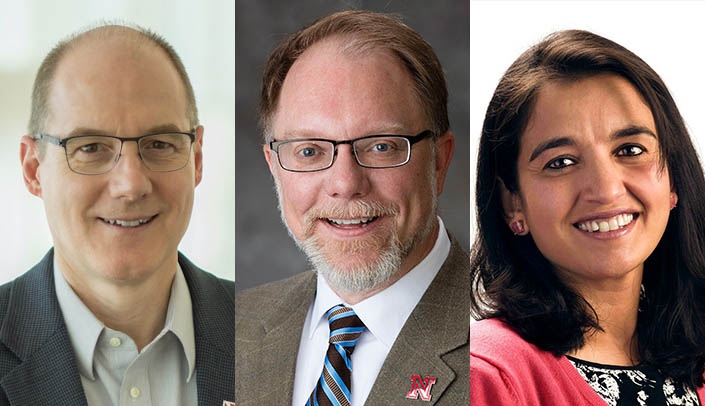A partnership involving the University of Nebraska and the Los Alamos National Laboratory in New Mexico could position Nebraska as a leading educational site for students seeking careers in the biodefense field.
The partnership was made possible through a meeting of the two institutions arranged by the National Strategic Research Institute (NSRI), which is headquartered on the University of Nebraska Medical Center campus in Omaha. The NSRI is one of only 13 University Affiliated Research Centers (UARC) in the country, and the only UARC with a primary mission responsibility to deliver research solutions across the Combating Weapons of Mass Destruction (chemical, biological, radiological and nuclear) portfolio.
The partnership with the University of Nebraska and Los Alamos is specifically looking into the diagnosis and detection of infectious disease agents through the use of biosensors, analytical devices that convert a biological response into an electrical signal. Biosensors can be used for detecting biological and chemical warfare agents, including nerve gases and anthrax spores.
Heading the collaborative effort for the University of Nebraska is Ken Bayles, Ph.D., professor, pathology/microbiology for UNMC. Mark Riley, Ph.D., associate dean for research for the University of Nebraska-Lincoln College of Engineering, is assisting Dr. Bayles on the UNL campus.
"Our goal," said Dr. Bayles, who is associate vice chancellor for basic science research, "is to make the University of Nebraska the go-to place for biodefense education for students ultimately hoping to work for the Department of Defense.
"The vision is to build an education pipeline that starts at the undergraduate level and continues right on through the graduate level. It will ultimately provide unique educational opportunities for Nebraska that we hope will draw the brightest students from Nebraska and around the country."
In mid-March, key people from the partnering institutions met in Omaha for a mini-symposium.
"We are interested in technology development, new methods of analysis and modeling, and in translation and use of new schemes to monitor microbes in a variety of environments. We are especially interested in connections of students at the graduate and undergraduate levels," said Dr. Riley, who is professor of biological systems engineering at UNL.
He noted that UNL has one of the pre-eminent undergraduate research programs in the U.S. and could be a good avenue for connecting students.
The career applications are numerous, he said, ranging from public health areas to medical facilities, manufacturing environments, and municipal water systems.
Dr. Riley said the collaboration with UNL, UNMC and Los Alamos is in its "infancy," but he noted that about 10 UNL faculty attended the Omaha symposium and that more UNL faculty would like to become engaged.
Los Alamos was established in 1943 as one of the sites of the Manhattan Project. Its single purpose was to design and build an atomic bomb. Today, the basic mission of Los Alamos is to maintain the safety, security, and reliability of the nation’s nuclear deterrent. The laboratory works on nuclear nonproliferation and border security, energy and infrastructure security, and countermeasures to nuclear and biological terrorist threats.
Harshini Mukundan, Ph.D., a scientist and team leader in the chemistry division, is heading the partnership for Los Alamos.
She praised the collaboration, saying, "You can develop solutions through partnerships. You can accomplish much more as a whole than by working alone."
Dr. Mukundan works on the development of diagnostic and surveillance strategies for emerging infectious diseases and drug-resistant organisms.
She called the partnership "a technology exchange," noting that seven Los Alamos researchers attended the mini-symposium in Omaha, and that the collaboration also would feature a variety of opportunities for Nebraska students to participate in internships at Los Alamos.
Dr. Mukundan cited five of her associates at Los Alamos for playing a key role in the collaboration. The five scientists and their areas of expertise include:
—Claudia Mora, Ph.D., deputy division leader for chemistry – student pipeline;
—Scott White, Ph.D., program manager – program engagement and collaboration with NSRI at UNMC;
—Norman Doggett, Ph.D., scientist and team leader – nucleic acid-based diagnostic platforms and sequencing;
—Benjamin McMahon, Ph.D., deputy group leader for theoretical biology and biophysics – engaged entrepreneurs in informatics and analytics; and
—Jessica Sutherland, Ph.D., post-doctoral student – microbiology and infection.
UNMC has a Biological Safety Level-3 laboratory (BSL-3), which provides another important learning tool for students, Dr. Bayles said.
"We have a handful of students right now wanting to specialize in biodefense," he said, "but I could see it potentially expand dramatically to maybe 100."
Dr. Bayles said the Los Alamos program would complement an existing educational pipeline previously established between other Department of Defense laboratories, UNMC and the University of Nebraska at Omaha.
He hopes this educational pipeline program will eventually provide a "one-stop shopping" resource that serves as a portal to opportunities across the Department of Defense portfolio.
We are Nebraska Medicine and UNMC. Our mission is to lead the world in transforming lives to create a healthy future for all individuals and communities through premier educational programs, innovative research and extraordinary patient care.
